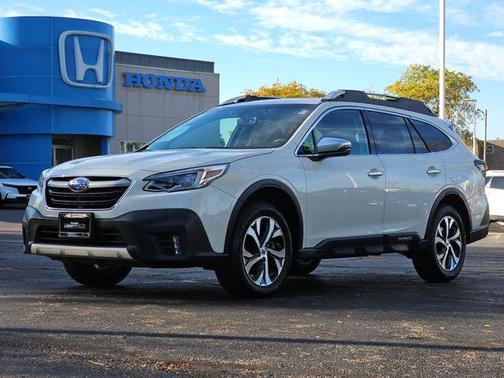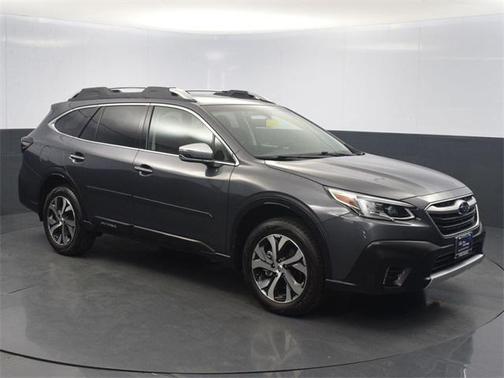Lower-body cladding — as in the rough-and-tumble plastic that girds fenders, bumpers and side sills — is a Subaru thing. Well, it’s an SUV thing. But Subaru’s outdoorsiest vehicles, especially raised wagons like the Crosstrek and Outback, make a fashion statement out of it, and the latest example comes in the Outback’s newest variant: the Onyx Edition.
2020 Subaru Outback Onyx Edition: 4 Ways It’s the Black Sheep of the Outback Family

Notable highlights
- ${price_badge()}
- ${battery_badge()}${ev_report_link()}
- ${hot_car_badge()}
- ${award_badge()}
- ${home_delivery_badge()}
- ${virtual_appointments_badge()}
- ${cpo_badge()}
- ${href_to_vdp()}
${price_badge_description}
The EV Battery Rating is based on this vehicle's current expected range relative to the vehicles expected range when new. ${battery_badge_text}
Certified cars are manufacturer warrantied and typically go through a rigorous multi-point inspection.
This car is likely to sell soon based on the price, features, and condition.
Looking to have this car delivered to your home? This dealership offers home delivery on some or all of its cars. Contact the dealership with our tools to get details such as qualifying cars, test drive options, and any applicable fees.
You can get more information about this car from your couch through a virtual appointment! Use our tools to contact the dealership to schedule a video consultation. A video walkaround of this car may be available upon request.
${award_blurb}
${award_two_blurb}
Shop the 2020 Subaru Outback near you


Added in the nameplate’s redesign for 2020, the Onyx technically goes by Onyx Edition XT, signaling that it carries the Outback’s available turbo four-cylinder engine. I recently test-drove a dark blue example, priced at $37,995 including options and a destination charge, and I’ll delve below into four key things that differentiate the Onyx from other Outbacks.
1. Exterior Details
Darkened exterior effects — dark wheels, a black upper grille strip where other trims use silver, and mirrors painted Crystal Black Silica — give the Onyx Edition a look that suggests hardier off-road chops, though its lower cladding isn’t technically any different than other Outback trims. Likewise, the Onyx has identical dimensions, including the same 8.7 inches of ground clearance, as other Outback trims.
2. Interior Touches
Inside, the Onyx gets a unique two-tone gray design scheme, and the seats have a water-repellent material called StarTex (not to be confused with the socially repellent material called Star Trek, which my wife still refuses to watch). StarTex feels smoother than traditional vinyl upholstery, though not exactly in an upscale way. Water resistance notwithstanding, I doubt many shoppers will mistake it for leather — but it does appear easy to clean.
3. More Modes Off Roads
Subaru introduced X-Mode, a driver-selectable setting that optimizes traction control and all-wheel-drive torque distribution for off-pavement situations, in the 2014 Forester, and it’s proven helpful in our experience. With the 2020 Outback’s Onyx Edition, X-Mode gets two modes versus the single setting in other Outback trims; that’s a provision Subaru also offers on the Forester. You still have a Snow and Dirt mode, but the Onyx adds Deep Snow and Mud. (There’s also a default mode, Normal — essentially turning X-Mode off — that keeps AWD engaged.)
What’s the difference? Snow and Sand mode manages drivetrain and stability-system control “to limit wheel spin and enhance traction,” Subaru spokeswoman Jessica Tullman said in an email. By contrast, “Deep Snow/Mud increases engine torque and allows for more wheel spin to help the vehicle find grip on these trickier surfaces.”
The calibrations for the latter mode provide “a marked difference in performance from regular X-Mode in those conditions,” Tulman said.
I ran our Onyx Edition through my standard AWD test, with the right wheels in low traction — in this case, a few inches of wet mud — and the left wheels on pavement. With X-Mode’s Normal or Snow and Dirt modes engaged, the Outback got out well enough, though there was some notable hesitation on the starboard side. By contrast, Deep Snow and Mud mode kept all four wheels rotating at roughly even speed to move out with no drama.
With all four wheels off the pavement, all three driving modes proved impressive. The Outback clawed its way resolutely through dirt and mud with minimal bogging down, a showcase of continuous power from Subaru’s venerated AWD. Deep Snow and Mud mode dialed back throttle sensitivity notably more than the Dirt and Snow mode, but even in Normal mode — theoretically worst suited for these settings — the Outback pulled through OK.
More From :
- 2020 Subaru Outback: 10 Things We Like and 3 Things We Don’t
- 2020 Subaru Outback First Drive: Your Budget Volvo Cross Country Has Arrived
- 2020 Subaru Outback Still Not Showy, Better Where It Counts
- 12 New Can’t-Miss Things About the 2020 Subaru Outback
- 2020 Subaru Outback: Familiar on Its Face, All-New Underneath
4. Turbo for Less
Given that the Outback starts at less than $28,000, our Onyx Edition’s as-tested price will doubtless land some readers in sticker shock — but it’s actually the cheapest way to get the Outback’s turbo engine. With pricing starting at $35,905 (all figures include destination), the Onyx Edition XT starts for thousands less than the Outback’s Limited XT ($38,755) and Touring XT ($40,705) trims. Those are the only three trims that have the wagon’s turbocharged 2.4-liter four-cylinder (260 horsepower, 277 pounds-feet of torque), a welcome upgrade over the non-turbo 2.5-liter four-cylinder (182 hp, 176 pounds-feet of torque).
The base engine, which I’ve also tested previously in the 2020 Outback, sells what it has up front, with sprightly enough power off the line. Press the gas harder, and there’s little extra in reserve, a paucity that reveals itself when going up on-ramps or in highway passing maneuvers. (It’s worth noting that reviewer Aaron Bragman disagrees; he found the base engine well matched to the Outback.)
The turbo four-cylinder solves any of those complaints and then some, with loads of torque available across a wide range of engine rpm. It makes the Outback legitimately quick. Both engines would benefit greatly from a stepped transmission — Subaru pairs them with a continuously variable automatic that, short of stomping on the gas, introduces too much nonlinearity between your right foot and engine power — but if Subaru giveth (almost) only CVTs, the turbo remains a worthwhile upgrade.
’s Editorial department is your source for automotive news and reviews. In line with ’s long-standing ethics policy, editors and reviewers don’t accept gifts or free trips from automakers. The Editorial department is independent of ’s advertising, sales and sponsored content departments.
